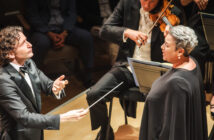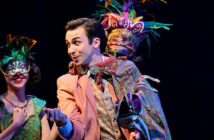
Place des Arts
Montréal, Quebec
September 13, 2011
Ever since its premiere in 1949, audiences have been moved and thrilled by Olivier Messiaen’s massive Turangalîla Symphony. More than 60 years later, it remains an extraordinarily original and peculiar piece. Montreal has heard it before – Charles Dutoit championed the piece in 2000 at Place des Arts. Kent Nagano has a special relationship with the composer and his music, and conducted this latest performance with both love and authority. The OSM responded with spectacular playing.
La Maison symphonique, the new home for OSM and others, including OSM’s rival, the Orchestre Métropolitain (still led by Philadelphia-bound Yannick Nezet-Seguin) opened last week with OSM performances of the Beethoven Ninth. The following week the OSM gave us the Turangalîla Symphony, an apt choice to really test the hall’s ability to handle both great masses of sound and a vast range of instrumental colours.
With Turangalîla, La Maison symphonique emerged a winner as it easily handled the enormous volume throughout the work without distortion, and most instruments could be clearly heard in both soft and loud passages; however, from my seat in the back of the Balcony – the highest tier in the hall – the overall orchestral sound was overly bright. I was reminded of the hard-edged early digital recordings from the 1980s: plenty of clarity, but not much warmth. In spite of the wood on the walls and floors all around me and on the stage below, the sound reaching the top tier was more steely than woody. As with most halls, the sound likely varies – sometimes considerably – depending on seat location. We’ll see.
Turangalîla, with an approximate playing time of 80 minutes, is often the sole piece on a programme. Not so on this occasion. In the first half of the concert, we had violinist Joshua Bell playing music by Tchaikovsky and Glazunov. This meant not only that the evening’s programme was very long, but also that it was expensive; Bell, one of the few classical artists likely to sell out a concert these days, doesn’t come cheap, and Turangalîla, with an exceptionally large orchestra including 11 percussionists, not to mention two featured keyboard soloists, is costly to mount.
Turangalîla is an event in itself. With nearly all OSM concerts conducted by Nagano selling very well, and with listeners eager to hear the new hall, why did the OSM management combine Bell and Turangalîla in one concert? Either one on its own is very costly and the two together would be tough on any orchestra’s budget. At a time when orchestras everywhere are struggling to avoid deficits, this programming looks like utter foolishness. The irony is that the OSM almost certainly would have sold out Joshua Bell and Turangalîla in separate concerts; to combine them in one concert probably jacked up their costs inordinately, while raising hardly a dollar more in revenue.
“Turangalîla” is a made-up word from Sanscrit meaning “love song.” There are love songs in the symphony, but no explicit programme or story. What makes this piece symphonic is the recurrence and development of themes. Messiaen, in many of his works, was inspired by both bird song and Indian music. The themes in his pieces are often easily recognizable, occasionally approaching what some would call “smaltzy.”
Turangalîla is odd in its harmonies and rhythms and in its unusual sounds. It is also very difficult to play, even for a virtuoso orchestra. The OSM musicians were equal to everything the composer threw at them and played superbly. The piano part is very demanding but ultimately unrewarding for the soloist with everything else that is going on in the piece. Angela Hewitt was a surprising soloist given her reputation for Bach and Mozart, but she made a very strong impression. Québec ondes martenot specialist Jean Laurendeau, positioned at the front of the orchestra, seemed in total command of this unusual instrument.
Joshua Bell, in great form, gave Tchaikovsky and Glazunov accurate and heartfelt performances. The OSM accompanied with sensitivity and panache. Associate principal horn Denys Derome contributed some beautiful solo playing.
It will likely take time for musicians and listeners alike to accustom themselves to La Maison symphonique. As I have said already, one concert experienced from one location in the hall does not provide enough information for firm conclusions about acoustical strengths and weaknesses. My impressions of the non-acoustical features of the hall, however, are another matter.
To begin with, anyone thinking of attending a concert La Maison symphonique should know that (as of September 13) the building and its environs are by no means finished. The outdoor surroundings are still walled off by wooden hoardings, and the lobby space is still under construction, especially at the top level. On the night I attended, the few existing escalators were not in service. Unfortunately, even putting the unfinished state of the building aside, the overall concept and layout of La Maison symphonique are, in my opinion, disappointing.
The new hall is part of Place des Arts and many patrons will enter through the dark, claustrophobic passages with low ceilings linking all the theatres. The main lobby of La Maison symphonique is so small and unimaginative that I was reminded of the worst of the Soviet era public buildings. To say the hall is uninviting would be an understatement. The audience enters through purely functional glass doors and almost immediately bumps up against a purely functional staircase. The message is ‘Get in or get out but don’t hang around here. Nothing to see here. Just keep moving.’ Emergency rooms in hospitals are designed with more aesthetic flair than this new arts facility.
There are only a single staircase and a few elevators leading to all floors. Getting 2,000 people in or out in a hurry is a problem. The beechwood lobby floors look nice, but after a few Montreal winters and a thousand cups of coffee spilled on them, will they still be attractive? The lobby space on each of the upper floors is tight and Spartan.
My general impression? Most of the money may or may not have been spent getting the acoustics right. We’ll see about that. Almost no money has been spent making the lobbies friendly and interesting, nor on moving people around the building quickly and safely. I see that the architectural design is credited to Jack Diamond. Was this really the best he could do?
Paul E. Robinson is the author of Herbert von Karajan: the Maestro as Superstar, and Sir Georg Solti: His Life and Music. NEW for friends: The Art of the Conductor podcast, Classical Airs.














